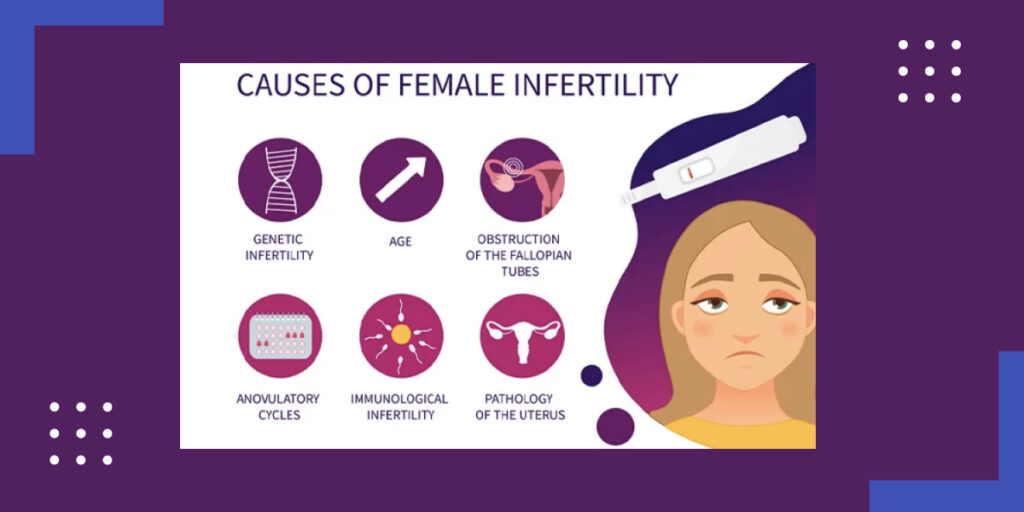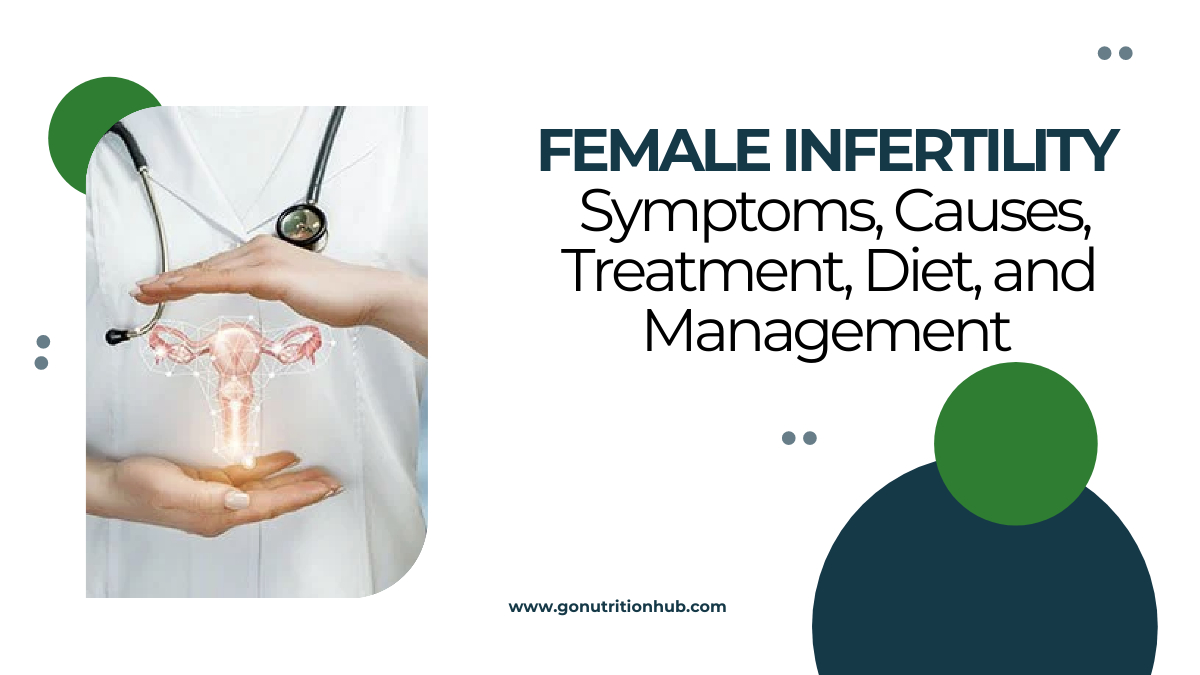Female infertility refers to the inability of a woman to become pregnant after trying for an extended period of time. It can be caused by several factors such as hormonal imbalances, blockages in the fallopian tubes, uterine problems, ovulation disorders, or age. Treatment options include medication, surgery, assisted reproductive technology (ART), or lifestyle changes. Consulting a fertility professional is recommended.
When to consult a doctor?
A woman should consider consulting a doctor for female infertility if:
She has been trying to conceive for a year or more without success
- She has irregular menstrual cycles or no menstrual cycles
- She has a history of pelvic infections, sexually transmitted infections, or previous surgeries
- She experiences pain during intercourse or heavy bleeding during periods
- She has a history of infertility in her family
It is important to seek medical advice early, as fertility problems can become more difficult to treat with time. A doctor can help diagnose the underlying cause of infertility and recommend the best course of treatment.
Symptoms of Female Infertility
The symptoms of infertility in women can include:
- Irregular or absent menstrual cycles
- Painful or heavy periods
- Ovarian cysts
- Pelvic pain or discomfort
- Difficulty in getting pregnant after trying for a period of one year or more
- Endometriosis
- Uterine fibroids
- Age-related decline in fertility
It is important to note that many women with infertility may have no noticeable symptoms. Consulting a doctor is the best way to determine if there is a fertility issue.
Causes for Female Infertility:

- Ovulation disorders: Infrequent or absent ovulation can prevent the release of eggs and lead to infertility.
- Tubal infertility: The fallopian tubes can become damaged or blocked, preventing the sperm and egg from meeting.
- Uterine or cervical problems: Structural problems in the uterus or cervix, such as fibroids or a malformed uterus, can interfere with fertility.
- Pelvic inflammatory disease (PID): PID is an infection of the reproductive organs that can cause permanent damage to the fallopian tubes.
- Endometriosis: This is a condition where the tissue that normally grows inside the uterus grows outside of it, causing pain and infertility.
- Polycystic ovary syndrome (PCOS): PCOS is a hormonal disorder that affects ovulation and fertility.
- Premature ovarian failure: This is a loss of normal ovarian function before the age of 40.
- Age: A woman’s fertility naturally decreases with age, making it more difficult to conceive.
- Lifestyle factors: Certain lifestyle factors, such as smoking, alcohol consumption, and being overweight or underweight, can impact fertility.
- Hormonal imbalances: Hormonal imbalances, such as thyroid disorders, can affect fertility.
It is important to note that sometimes the cause of infertility is unknown. An evaluation by a doctor can help determine the cause and the best course of treatment.
Risk Factors for Female Infertility
Risk factors for Female Infertility Include:
- Age: A woman’s fertility declines as she ages, especially after age 35.
- Lifestyle factors: Smoking, alcohol consumption, and the use of certain drugs can harm reproductive health.
- Body weight: Women who are significantly overweight or underweight may experience infertility.
- Medical history: Previous pelvic infections, sexually transmitted infections, or surgeries can increase the risk of infertility.
- Family history: A family history of infertility or genetic disorders can increase the risk.
- Endocrine disorders: Thyroid disorders, insulin resistance, and other endocrine disorders can affect fertility.
- Irregular menstrual cycles: Irregular or absent periods can be a sign of infertility.
- Exposure to environmental toxins: Certain chemicals and toxins, such as lead and pesticides, can harm reproductive health.
- Stress: High levels of stress can interfere with ovulation and conception.
- Polycystic ovary syndrome (PCOS): PCOS is a hormonal disorder that can lead to infertility.
It is important to note that having one or more of these risk factors does not necessarily mean that a woman will experience infertility. An evaluation by a doctor can help determine the cause and the best course of treatment.
Diagnosis in Female Infertility
Diagnosing infertility in women typically involves a series of tests to determine the cause of the problem. Some common tests used to diagnose female infertility include:
- Ovarian reserve testing: This involves measuring the quantity and quality of the eggs in a woman’s ovaries. Tests may include follicle-stimulating hormone (FSH) levels, anti-müllerian hormone (AMH) levels, and ultrasound.
- Hormonal evaluation: This involves measuring levels of hormones, such as luteinizing hormone (LH), follicle-stimulating hormone (FSH), and estrogen, which play a role in ovulation and fertility.
- Ovarian function testing: This involves evaluating the function of the ovaries, including monitoring ovulation and measuring levels of hormones such as progesterone.
- Tubal patency testing: This involves testing the fallopian tubes to determine if they are blocked, which can prevent eggs from reaching the uterus. Tests may include a hysterosalpingogram (HSG), sonohysterogram (SHG), or laparoscopy.
- Pelvic ultrasound: This involves using sound waves to create an image of the reproductive organs, including the ovaries, uterus, and fallopian tubes.
- Endometrial biopsy: This involves removing a small sample of the uterine lining for laboratory testing to determine if the endometrial lining is receptive to a fertilized egg.
- Hysteroscopy: This involves using a small scope to examine the inside of the uterus and identify any structural problems that may be affecting fertility.
It is important to consult a doctor to determine the best approach for diagnosing infertility. The doctor may recommend one or more tests based on individual medical history and symptoms. Early diagnosis and treatment can improve the chances of success with infertility treatments.
Treatment and Management of Female Infertility

Treatment and management of female infertility depend on the underlying cause, but can include:
Medication: Fertility drugs can stimulate ovulation or regulate hormones to improve the chances of pregnancy.
Medication is a common treatment for female infertility, and the type of medication depends on the underlying cause of infertility. Some of the medications used for female infertility include:
Clomiphene citrate (Clomid): Clomid is a fertility drug that stimulates ovulation.
Gonadotropins: These are the hormones that stimulate the ovaries and help to produce eggs.
Metformin: Metformin is a diabetes drug that can improve insulin resistance and regulate menstrual cycles in women with polycystic ovary syndrome (PCOS).
Letrozole: Letrozole is a cancer drug that can stimulate ovulation in women with infertility caused by anovulation.
Bromocriptine: Bromocriptine is a drug that can regulate hormones and improve ovulation in women with infertility caused by hormonal imbalances.
It is important to discuss any medication options with a doctor, as fertility drugs can have side effects and may not be suitable for all women. Additionally, some women may need to try multiple medications before finding one that is effective.
Fertility drugs may also need to be used in combination with other treatments, such as assisted reproductive technology (ART), to achieve a successful pregnancy.
Surgery: Certain surgical procedures, such as laparoscopy or hysteroscopy, can treat infertility caused by structural problems in the reproductive organs.
Surgery is a treatment option for female infertility, and the type of surgery depends on the underlying cause of infertility. Some of the surgeries used for female infertility include:
Laparoscopy: Laparoscopy is a minimally invasive surgery that can be used to diagnose and treat various fertility issues, such as endometriosis, adhesions, and fibroids.
Hysteroscopy: Hysteroscopy is a procedure that uses a thin, lighted scope to examine the inside of the uterus and treat issues, such as uterine fibroids, polyps, and adhesions.
Tubal ligation reversal: Tubal ligation reversal is a surgical procedure that can restore fertility in women who have had their fallopian tubes cut or blocked for contraception.
Ovarian drilling: Ovarian drilling is a procedure that uses lasers or radiofrequency to make small holes in the ovary and improve ovulation in women with PCOS.
Uterine septum resection: A uterine septum is a condition in which the uterus is divided into two separate cavities. A uterine septum resection is a surgical procedure that can correct this condition and improve fertility.
It is important to discuss any surgical options with a doctor, as surgery can have risks and may not be suitable for all women. Additionally, some women may need to try multiple treatments, such as medication or ART, before considering surgery.
The success of surgery for infertility depends on the underlying cause of infertility and the type of surgery being performed.
Assisted reproductive technology (ART): ART refers to various methods, such as in vitro fertilization (IVF), to help couples conceive.
Assisted reproductive technology (ART) is a type of treatment for female infertility that involves using medical procedures to help women conceive. Some of the ART techniques used for female infertility include:
In vitro fertilization (IVF): In vitro fertilization is a process in which eggs from the ovaries are retrieved and in a laboratory dish, it fertilizes with sperm. The resulting embryos are transferred back into the uterus.
Intracytoplasmic sperm injection (ICSI): ICSI is a procedure in which a single sperm is injected directly into an egg to fertilize it. ICSI is used when the male partner has a low sperm count or low sperm motility.
Frozen embryo transfer (FET): FET is a procedure in which embryos that were previously frozen during an IVF cycle are thawed and transferred back into the uterus.
Donor egg and sperm: In some cases, women may use donor eggs or sperm if they are unable to produce their own eggs or sperm.
Surrogacy: Surrogacy is a process in which a woman carries and delivers a baby for another person or couple.
It is important to discuss any ART options with a doctor, as ART can be expensive and may not be covered by insurance. Additionally, some women may not be suitable candidates for ART, such as women with certain medical conditions.
The success of ART depends on various factors, including the underlying cause of infertility, the age of the woman, and the type of ART being performed.
Lifestyle changes – Female Infertility
Maintaining a healthy weight, reducing stress, and avoiding harmful substances can improve fertility.
Lifestyle changes can help improve fertility and reduce the risk of infertility in women. Some of these changes include:
Maintaining a healthy weight: Being overweight or underweight can have a negative impact on fertility. A healthy balanced diet and regular exercising can help to maintain a healthy weight.
Reducing stress: High levels of stress can interfere with ovulation and conception. Practices like yoga or meditation can help relieve stress.
Avoiding harmful substances: Smoking, alcohol, and certain drugs can harm reproductive health. Quitting these habits can improve fertility.
Eating a healthy diet: A diet that is rich in fruits, vegetables, whole grains, and lean protein can help improve fertility.
Getting enough sleep: Adequate sleep can help regulate hormones and improve overall health.
Limiting caffeine and sugar: High levels of caffeine and sugar can interfere with fertility.
Taking prenatal vitamins: Taking prenatal vitamins can help ensure that the body has all of the necessary nutrients for a healthy pregnancy.
It is important to discuss any lifestyle changes with a doctor before starting them, especially for women who are trying to conceive.
Additionally, some women may need to make other changes, such as reducing exposure to environmental toxins, to improve their fertility.
Intrauterine insemination (IUI): IUI involves placing sperm inside the uterus to increase the chances of fertilization.
Intrauterine insemination (IUI) is a type of assisted reproductive technology (ART) used for female infertility. IUI involves placing sperm directly into the uterus to increase the chance of fertilization.
IUI can be used for women with fertility issues such as:
Ovulation disorders: IUI can help women who do not ovulate regularly to conceive by increasing the number of sperm available for fertilization.
Cervical mucus problems: IUI can help women with cervical mucus problems by bypassing the cervix and placing sperm directly into the uterus.
Unexplained infertility: IUI can be used for women who have been diagnosed with unexplained infertility.
Male factor infertility: IUI can help couples where the male partner has low sperm count or motility.
IUI is a relatively simple and non-invasive procedure that can be performed in a doctor’s office. The success of IUI depends on various factors, including the underlying cause of infertility, the age of the woman, and the number of treatments attempted.
It is important to discuss any IUI options with a doctor, as IUI may not be suitable for all women and may need to be used in combination with other treatments, such as medication or in vitro fertilization (IVF), to achieve a successful pregnancy.
Donor eggs or sperm: In some cases, donor eggs or sperm may be used to help couples conceive.
Adoption: For couples who are unable to conceive, adoption is another option.
It is important to work closely with a doctor to determine the best course of treatment. Some treatments may not be suitable for all women, and multiple treatments may be necessary before achieving a successful pregnancy. Additionally, some women may choose to pursue alternative treatments, such as acupuncture or herbal remedies, but it is important to discuss these options with a doctor before starting any new treatment.
Dietary Modifications – Female Infertility
Dietary modifications can play a role in improving female fertility. Some dietary changes that may help improve fertility include:
- Eating a balanced diet: Consuming a balanced diet rich in fruits, vegetables, whole grains, and lean proteins can provide the necessary nutrients for healthy ovulation and conception.
- Maintaining a healthy weight: Being overweight or underweight can affect ovulation and fertility. A right balanced diet and regular exercise can help in maintaining a healthy weight.
- Limiting caffeine and alcohol: Consuming large amounts of caffeine and alcohol can reduce fertility. It is recommended to limit caffeine intake to less than 200 mg per day and to limit alcohol consumption to no more than one drink per day.
- Incorporating folic acid: Folic acid is an important nutrient for fetal development and should be consumed before and during pregnancy. Folic acid can be found in fortified cereals, leafy greens, and beans.
- Avoiding trans fats: Trans fats are unhealthy fats that can reduce fertility and increase the risk of infertility. It is important to avoid trans fats and to consume healthy unsaturated fats, such as those found in nuts, seeds, and fish.
- Incorporating iron-rich foods: Iron is an important nutrient for reproductive health and can be found in foods such as red meat, poultry, and fortified cereals.
It is important to talk to a doctor or a registered dietitian before making significant dietary changes, especially for women with medical conditions or who are taking medication.
A doctor can help determine the best dietary changes for individual needs and help ensure that any changes made are safe and beneficial for overall health and fertility.
Essential Nutrients Required In Female Infertility
Essential nutrients play a crucial role in maintaining good reproductive health and improving fertility. Some essential nutrients for female fertility include:
Folic acid: Folic acid is a B-vitamin that helps reduce the risk of birth defects and is essential for the healthy development of the fetus. It can be found in leafy green vegetables, fortified cereals, and legumes.
Iron: Iron is important for maintaining healthy ovaries and the production of eggs. Iron-rich foods include red meat, poultry, and fortified cereals.
Vitamin D: Vitamin D plays a role in ovulation and the production of hormones. Vitamin D can be found in fortified milk, eggs, and fatty fish along with sunlight.
Zinc: Zinc is important for the production of hormones and the maintenance of healthy eggs. Zinc-rich foods include oysters, beef, and fortified cereals.
Omega-3 fatty acids: Omega-3 fatty acids play a role in maintaining hormonal balance and improving egg quality. Omega-3 fatty acids can be found in fatty fish, such as salmon, as well as in flaxseeds and walnuts.
Coenzyme Q10 (CoQ10): CoQ10 is an antioxidant that helps improve egg quality and protects against oxidative stress. Whole grains, fatty fish, and organic meats are the food sources of CoQ10.
Vitamin B12: Vitamin B12 plays a role in the production of red blood cells and helps maintain healthy nerves and DNA. Vitamin B12 can be found in animal products, such as meat, poultry, and dairy.
It is important to note that the specific nutritional requirements for fertility may vary from woman to woman, and it is best to consult with a doctor or a Registered Dietitian to determine the appropriate intake of essential nutrients for individual needs.
Physical Activity in Female Infertility:
Physical activity can play a role in improving female fertility and can be a beneficial part of a comprehensive infertility treatment plan. Some ways in which physical activity can improve female fertility include:
- Maintaining a healthy weight: Physical activity can help maintain a healthy weight, which is important for ovulation and fertility.
- Reducing stress: Regular physical activity can help reduce stress, which can have a negative impact on fertility.
- Improving circulation: Physical activity can improve circulation and increase blood flow to the reproductive organs, which can help improve fertility.
- Regulating hormones: Physical activity can help regulate hormones and improve ovulation, which is essential for fertility.
It is recommended to engage in moderate-intensity physical activity, such as brisk walking, cycling, or swimming, for at least 30 minutes a day, most days of the week.
Women who are overweight or have medical conditions should talk to their doctor before starting a new physical activity routine.
It is also important to avoid extreme or strenuous physical activity, such as long-distance running or intensive weightlifting, as this can have a negative impact on fertility. It is best to consult with a doctor or a physical therapist to determine the appropriate type and level of physical activity for individual needs and goals.
Exercises advisable for female infertility
Exercise can play a role in improving female fertility and can be a beneficial part of a comprehensive infertility treatment plan. Some exercises that are advisable for female infertility include:
Aerobic exercise: Aerobic exercises, such as brisk walking, cycling, or swimming, can help regulate hormones, reduce stress, and improve circulation, which are all important for fertility.
Yoga: Yoga can help reduce stress, improve circulation, and regulate hormones, which are all important for fertility.
Pelvic floor exercises: Pelvic floor exercises, also known as Kegel exercises, can help improve blood flow to the reproductive organs and strengthen the pelvic muscles, which can help improve fertility.
Strength training: Strength training, such as weightlifting or resistance band exercises, can help maintain a healthy weight, improve circulation, and regulate hormones, which are all important for fertility.
It is recommended to engage in moderate-intensity physical activity, such as brisk walking, cycling, or swimming, for at least 30 minutes a day, most days of the week.
Women who are overweight or have medical conditions should talk to their doctor before starting a new exercise routine.
It is also important to avoid extreme or strenuous physical activity, such as long-distance running or intensive weightlifting, as this can have a negative impact on fertility.
It is best to consult with a doctor or a physical therapist to determine the appropriate type and level of exercise for individual needs and goals.
Prevention:
Preventing female infertility can be difficult, as some causes are beyond control, such as age and genetic factors. However, there are certain steps that can help reduce the risk of infertility:
Healthy weight: Being overweight or underweight may have a negative impact on fertility.
Avoid harmful substances: Smoking, alcohol, and certain drugs can harm reproductive health.
Manage stress: High levels of stress can interfere with ovulation and conception.
Treat underlying medical conditions: Certain medical conditions, such as thyroid disorders or endocrine disorders, can impact fertility.
Practice safe sex: Sexually transmitted infections can cause pelvic inflammatory disease (PID), which can lead to infertility.
Limit exposure to environmental toxins: Certain chemicals and toxins, such as lead and pesticides, can harm reproductive health.
Use contraception: Unintended pregnancy can delay or prevent the ability to conceive later on.
It is important to discuss any concerns about fertility with a doctor, especially before trying to conceive. Early detection and treatment of infertility can increase the chances of a successful pregnancy. Additionally, some women may choose to freeze their eggs for future use, but it is important to discuss this option with a doctor before making any decisions.
SUMMARY – Female Infertility
Female infertility is a condition in which a woman is unable to conceive after trying for a year or more. It can be caused by a variety of factors, including hormonal imbalances, structural problems, age, lifestyle factors, and certain medical conditions.
Diagnosis typically involves a series of tests to determine the cause of infertility, including ovarian reserve testing, hormonal evaluation, tubal patency testing, pelvic ultrasound, endometrial biopsy, and hysteroscopy.
Treatment options for female infertility include lifestyle changes, such as maintaining a healthy weight, eating a balanced diet, reducing stress, and engaging in regular physical activity.
Medications, such as fertility drugs, and assisted reproductive technologies (ART), such as insemination and in vitro fertilization (IVF), can also be used.
In some cases, surgery may be necessary to correct structural problems or remove cysts or growths that are affecting fertility.
It is important to consult a doctor as soon as possible if trying to conceive becomes difficult. Early diagnosis and treatment can improve the chances of success with infertility treatments.



